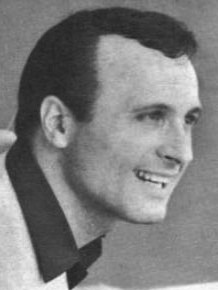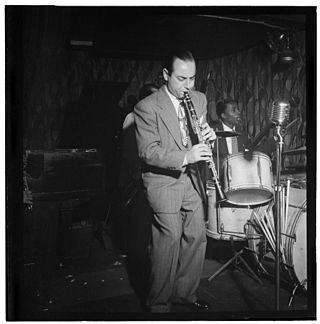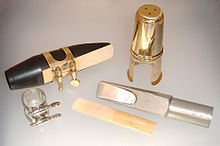
Benjamin David Goodman was an American clarinetist and bandleader known as the "King of Swing".

Eugene Bertram Krupa, known as Gene Krupa, was an American jazz drummer, bandleader and composer who performed with energy and showmanship. His drum solo on Benny Goodman's 1937 recording of "Sing, Sing, Sing" elevated the role of the drummer from an accompanist to an important solo voice in the band.

Philip Wells Woods was an American jazz alto saxophonist, clarinetist, bandleader, and composer.

Nino Tempo is an American musician, singer, and actor. He was a duet partner with his older sister April Stevens as well as the frontman for a 1970s funk band, 5th Ave. Sax.
Leon Brown "Chu" Berry was an American jazz tenor saxophonist during the 1930s.

Michael Andrew "Peanuts" Hucko was an American big band musician. His primary instrument was the clarinet, but he sometimes played saxophone.

Billy Bauer was an American jazz guitarist.

Leonard William Hambro, known as Lenny Hambro, was a journeyman jazz musician who played woodwinds, primarily alto saxophone, with a host of bands, orchestras, and jazz notables from the early 1940s through the mid-1960s, and continued as a session musician, music producer, booking agent, and entertainment coordinator through the mid-1990s. Early in his professional career, Hambro spelled his name "Lennie" but changed it to the former spelling in 1954, although he was occasionally referred to as "Lennie" in the press as late as 1957. Hambro broke into the profession with Gene Krupa in 1942. However, he is best known for his time as manager and assistant band leader with the New Glenn Miller Orchestra under the direction of Ray McKinley. He was well known in the Latin Jazz community and was closely associated with Chico O’Farrill.
Bernie Glow was an American trumpet player who specialized in jazz and commercial lead trumpet from the 1940s to 1970s.
Murray McEachern was a Canadian jazz trombonist and alto saxophonist, perhaps best known for having played trombone for Benny Goodman from 1936 to 1937. McEachern is also remembered for playing both the trombone and alto saxophone for the Casa Loma Orchestra from 1937 to 1941.
Abraham Samuel Richman, better known as Boomie Richman, was an American jazz tenor saxophone player who played with Tommy Dorsey. He also played clarinet, bass clarinet, piccolo, and flute.

Donald Douglas Lamond Jr. was an American jazz drummer.

Lady Day: The Complete Billie Holiday on Columbia 1933–1944 is a 10-CD box set compiling the complete known studio master recordings, plus alternate takes, of Billie Holiday during the time period indicated, released in 2001 on Columbia/Legacy, CXK 85470. Designed like an album of 78s, the medium in which these recordings initially appeared, the 10.5" × 12" box includes 230 tracks, a 116-page booklet with extensive photos, a song list, discography, essays by Michael Brooks, Gary Giddins, and Farah Jasmine Griffin, and an insert of appreciations for Holiday from a diversity of figures including Tony Bennett, Elvis Costello, Marianne Faithfull, B.B. King, Abbey Lincoln, Jill Scott, and Lucinda Williams. At the 44th Grammy Awards on February 27, 2002, the box set won the Grammy Award for Best Historical Album of the previous year.

Herbert Arnold Geller was an American jazz saxophonist, composer and arranger. He was born in Los Angeles, California, United States.
Walt Levinsky was an American big band and orchestral player, composer, arranger, and bandleader. While many of his big band assignments were as lead alto sax player, his favorite instrument was the clarinet.
Arthur Ryerson was a jazz guitarist who emerged in the 1930s, playing acoustic and electric guitar, as well as the banjo. He played with jazz orchestras and bands in the 1930s and the 1940s. In the early 1950s, he played on several early rock and roll recordings of Bill Haley. His daughter is flautist Ali Ryerson.
Charles T. Gentry was an American jazz saxophonist.
Joseph P. Lippman was an American composer, arranger, conductor, pianist, and songwriter working in jazz and traditional pop. His musical career was over five decades long, having started at age 19 with the Benny Goodman orchestra in 1934 and writing for television, films, and Broadway in the 1980s. He composed and arranged for Bunny Berigan, Jimmy Dorsey, Sarah Vaughan, Charlie Parker and worked as staff arranger in television for Perry Como and Hollywood Palace.
Anita Blanch Boyer Dukoff, known as Anita Boyer was an American singer of the Big Band Era, described by Billboard as "one of the music business's most proficient canaries". She was noted for performances with Tommy Dorsey (1939), Leo Reisman (1940–41), Artie Shaw (1940), Nat King Cole (1941–44), Jerry Wald (1942–43) and Hoagy Carmichael (1945). With Dorsey she helped popularize the song "I Concentrate On You", and with Reisman she recorded the song "Bewitched, Bothered and Bewildered" for Pal Joey.










